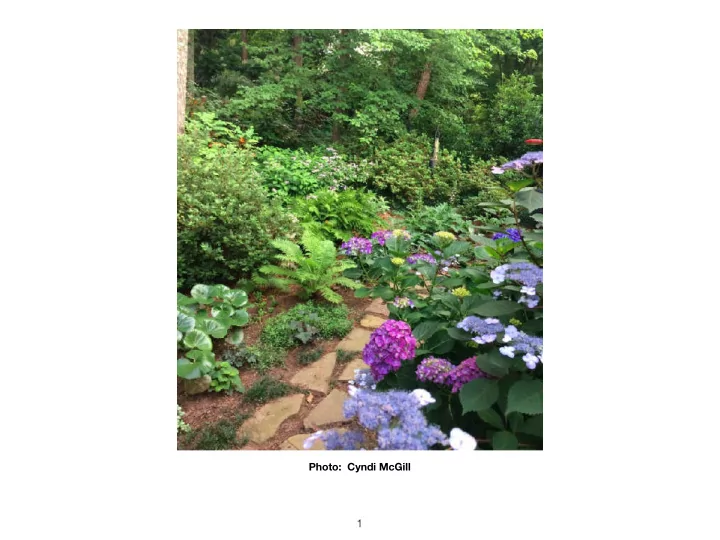

Photo: Cyndi McGill � 1
Made In The Shade Dunwoody Community Garden Workshop August 10, 2019 Cyndi McGill DeKalb County Master Gardener Extension Volunteer � 2
• Shade Basics • Working With Shade • Planting Under Trees • Shade Loving Plants • Shade Garden Tour � 3
� 4
So Who’s Throwin’ Shade? • Trees and Tall Shrubs • Buildings • Fences � 5
Full Sun • 6 hours or more of direct sun • A must for almost all vegetables, fruits, and turf • Preferred for many annuals and perennials such as roses Part Sun • 4-6 hours of direct sun, including afternoon sun • Suitable for some vegetables, fruits, and turf • Can work for many sun-loving annuals and perennials � 6
Part Shade… • Light Shade: Less than 4 hours of direct sun, or bright, indirect conditions all day (protected by shadows from permanent structures or trees) • Filtered Light: 4-6 hours of direct sun (excluding direct afternoon sun), with dappled light through deciduous trees or open structures • Medium Shade: 2-4 hours of direct sun and/or or all-day dappled light through trees • Woodland Shade: Medium Shade in the summer, Full Sun in the winter Remember: Light is cumulative! Deep Shade: No direct sunlight and little dappled light � 7
Plants Like What They Like… They tend to grow spindly and not flower without enough light They may wilt or scorch in too much sun …When In Doubt, Watch Them! � 8
Be One With The Shade • Be flexible! • Invest in your soil: well drained, plenty of organic matter • Foot tra ffi c solutions: mulch, gravel, stone � 9
Be One With The Shade • Plant selection: foliage vs. blooms • Pots are your friends! • Drainage and air circulation • Leave space between mulch and stems • Keep crowns clear � 10
Wranglin’ Shade • Consider “limbing up” trees to increase filtered light • Reflective paint can boost light in areas shaded by walls � 11
Dry Shade • Areas directly under tree canopies • Trees get first dibs on water and nutrients • Maples, conifers, and birch are most problematic � 12
Photo: Cyndi McGill � 13
Planting Under Trees: Do’s! • Get a soil test • Plant trees and understory elements at the same time • Consider “limbing up” to increase filtered light • Be realistic: use plants with smaller root balls to avoid trauma to tree roots • Use ground covers and elevated containers • Mulch to retain water • Carefully monitor for water and fertilizer needs � 14
Planting Under Trees: Don’ts! • Don’t sever large roots • Don’t install raised beds on top of tree roots • Don’t add more than 2-4 inches of mulch over the drip area of trees • Don’t place mulch or new plants directly against the tree trunks � 15
Plants for Shade Trees to Ground Cover � 16
Dogwood Cornus florida Photo: Missouri Botanical Garden � 17
Kousa Dogwood Cornus kousa ‘Wolf Eye’ Photo: Missouri Botanical Garden � 18
Carolina Silverbell Halesia carolina Photo: Missouri Botanical Garden � 19
Serviceberry Amelanchier arborea Photo: Missouri Botanical Garden � 20
Camellia japonica Photo: Missouri Botanical Garden � 21
Photos: Missouri Botanical Garden Azalea Rhododenron ‘Herbert’ Rhododendron Rhododendron ‘Anna H. Hall’ � 22
Flame Azalea Rhododendron calendulaceum Photo: Missouri Botanical Garden � 23
Mountain Laurel Kalmia latifolia Photo: NC State Extension � 24
Tea Olive Osmanthus fragrans Photo: Forest and Kim Starr, NC State Extension � 25
Gold Dust Plant Acuba japonica Photo: Cyndi McGill � 26
Leatherleaf Mahonia Mahonia bealei Photo: Barbara Goodman, NC State Extension � 27
Japanese Plum Yew Cephalotaxus harringtonia ‘Yewtopia’ Photo: Missouri Botanical Garden � 28
Fatsia japonica Photo: Cyndi McGill Fatsia ‘Spider Web’ Photo: Southern Living � 29
Beautyberry Callicarpa americana Photo: Missouri Botanical Garden � 30
Limelight Hydrangea paniculata Photo: Missouri Botanical Garden � 31
Big Leaf Hydrangea Hydrangea macrophylla Photos: Missouri Botanical Garden � 32
Climbing Hydrangea Hydrangea anomola Oakleaf Hydrangea Hydrangea quercifolia Photo: Missouri Botanical Garden Photo: Missouri Botanical Garden � 33
Tree Ivy Fatshedera lizei Photo: Missouri Botanical Garden � 34
� 35
Hosts of Hosta! Less Shade vs. More Shade ‘Blue Mouse Ears’ ‘Fragrant Bouquet’ ‘El Nino’ ‘Great Expectations’ Photos: Missouri Botanical Garden � 36
Lenten Rose Helleborus Photos: Missouri Botanical Garden � 37
Foamflower Tiarella Coral Bells Heuchera Photos: Missouri Botanical Garden � 38
Bear’s Breeches Acanthus mollis Photos: Missouri Botanical Garden � 39
Leopard Plant Farfugium japonica Photo: Missouri Botanical Garden � 40
Lungwort Pulmonaria ‘Trevi Fountain’ Photo: Missouri Botanical Garden � 41
Woodland Phlox Phlox divaricata Bleeding Heart Dicentra Photos: Missouri Botanical Garden � 42
Celandine Poppy Stylophorum diphyllum Turtlehead Photo: Jay Sturner Chelone lyonii Photo: Missouri Botanical Garden � 43
Solomon’s Seal Astilbe Polygonatum biflorum Photos: Missouri Botanical Garden � 44
Ferns Photos: Missouri Botanical Garden � 45
Shade-Tolerant Groundcovers • Vinca minor • Liriope (muscari vs spicata) • Creeping Jenny (Lysimachia nummularia) • Mondo Grass (Ophiopogon planiscapus) • Japanese Pachysandra (Pachysandra terminalis) � 46
Bugleweed Sweet Woodru ff Galium odoratum ‘Caitlin’s Giant’ Ajuga reptans Photo: Bluestone Perennials � 47 Photo: Missouri Botanical Garden
Deadnettle Veronica Lamium maculatum ‘Georgia Blue’ Photo: Missouri Botanical Garden Photo: Missouri Botanical Garden � 48
Shade Annuals � 49
� 50
Plant Sources • Dunwoody Community Garden and Orchard Plant Sales • Georgia Native Plant Society: GNPS.org � 51
Help is Available! DeKalb County Master Gardener Help Desk 404-298-4080 mgardener@dekalbcountyga.gov � 52
Recommend
More recommend